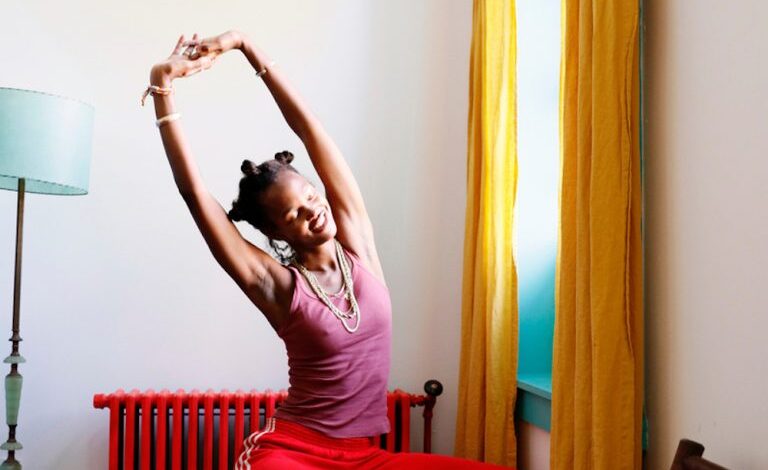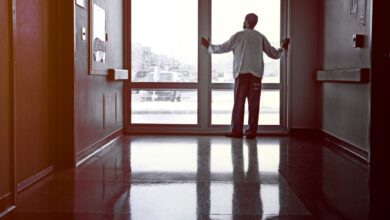9 Low-Impact Exercises a Trainer Swears by for Results

This summer in Texas has been particularly brutal when it comes to the heat. While I usually spend my summers exercising outdoors, with temperatures in the triple digits, anything that involves excessive movement is pretty much off the table. In the past few months, I’ve been on a mission to find the best way to stay in shape, not overheat, and still stay connected with nature. The result? A newfound love for low-impact exercise.
While you can always take an indoor yoga, bar, or cycling class to beat the heat, if you’re looking for exercises you can do at home without nearing heat exhaustion—we’ve got you covered. Jordan Hana, certified yoga teacher and yoga sculpt instructor, gave us the run-down on the benefits of keeping your movement low-impact, the best exercises to implement into your weekly routine, and how to do it all safely in the heat.
Featured image from our interview with Megan Roup by Michelle Nash.
What Makes Exercise Low-Impact
Low impact is simply just that—light (little to no) impact on your joints and at least one foot (if not both) connected to the ground. Low-impact exercises increase your heart rate slowly, are more fluid in motion, and are more gentle on the body. A few low-impact exercises include walking, yoga, pilates, barre, and swimming.
How Low-Impact Exercise Benefits the Body
Low-impact exercise is amazing for anyone and everyone. It’s generally safer and decreases your risk of injury as opposed to high-impact movement. Low-impact exercises tend to place some focus on flexibility, which is great for stability, alignment, and balance and can be used as a form of active recovery on days when you don’t want to rest but don’t want to overdo it.
I am a HUGE fan of low-impact workouts 5 times a week, but I know that many of us are yearning for a quick, high-intensity workout. I personally love three days of low impact, two days of high impact, and two days of rest. If, on a rest day, you want more, a low-impact walk is a perfect form of active recovery!
I’m not a doctor, but I genuinely think that low-impact exercises help with overall mental health—moving slowly, connecting with breath, and enjoying the workout—even a simple walk can do this!
How to Incorporate Low-Impact Exercise Into Your Week Workout Plan
If you’re looking to incorporate low-impact exercise into your weekly workout regime, Hana’s typical weekly workout schedule might help you get on track.
Monday: Barre
Tuesday: HIIT (a treadmill workout class)
Wednesday: Yoga
Thursday: HIIT (Cycling Class)
Friday: Pilates
Hana typically adds a walk into her weekly workout schedule as well—usually 2-3 days a week. It helps her get outside and take her two adorable pups for a walk. Outside time is key, not only for physical health but for boosting our mental wellness, too. Even just a 10-minute walk can do wonders. And if you’re avoiding the heat, try incorporating an early morning or evening walk into your routine.
Hana’s biggest note: get in tune with your body and start to listen to what it’s telling you. Soreness, injury, and major discomfort are telling you something is going on, and maybe you need to take a step back from the high-intensity workouts. If you’re new to fitness and unsure where to start, more low-impact workouts are definitely the way to go. And if you’re going the group fitness route, always let the instructor know you’re new! They love supporting beginners and helping you get the most from your workout.
Get in tune with your body and start to listen to what it’s telling you.
The Best Equipment for Low-Impact Exercise
Truly, the best thing about low-impact workouts is you really don’t need much! Your body weight is hands-down the best tool for low-impact exercises.
If you’re looking to expand your fitness equipment repertoire, a yoga mat is perfect to support your body so you’re not directly on the grass or concrete. I always like to incorporate hand weights—for a barre or pilates class, I suggest 3-5 pound weights—an exercise pilates ball (small, about six inches), and an exercise band. The addition of weights, pilates ball, and exercise bands allow you to expand and build more muscles, but moving slowly within these exercises ensures proper form and less risk of injury. Always the option to have a towel for sweat, music for good vibes, and water to hydrate—a definite MUST!
Every product is curated with care by our editors and we’ll always give an honest opinion, whether gifted or purchased ourselves. If you buy something through our links, we may earn a small commission at no cost to you.
Tips for Working Out in the Heat
Adding heat (whether outdoors or indoors) increases the stress you place on your body, meaning the temperature of your body is increasing. It also dehydrates the body as you lose more fluids during these workouts, basically meaning you can fatigue faster. Your body also can’t cool itself as fast, so just make sure to take adequate breaths and prioritize recovery and hydration to help support your body within these workouts.
My #1 tip: Hydrate, Hydrate, Hydrate—this is key to working out in the heat. Adding an electrolyte supplement to your water is also a great way to replenish the minerals you lose when sweating!
Other tips to think about:
- Wear the right clothing. Lightweight, sweat-resistant, and breathable materials that are light in color
- Know where you’re at. If you’re new to working out outdoors (or in the heat), start slowly and increase gradually. Know your limits, and don’t push it if you don’t have to.
- Use sunscreen outdoors. Another must!
9 Low-Impact Exercises a Trainer Loves
Overall workouts:
- Go for a 30-45 minute walk. This is a great way to enjoy the outdoors and get a sweat in without doing anything too strenuous.
- Yoga—Flow through some Sun A’s. One of the foundations of vinyasa yoga is sun salutations. Sun Salutation A is a series of nine movements that sync to your breath to help build balance and strength in a subtle way.
Squat + Oblique Twist
Also known as a ‘pop squat twist,’ this exercise targets your glutes, quads, and obliques. While it can be done without any equipment, you can add an exercise band around your upper calf to increase tension and turn on your glutes during your squat.
Donkey Kicks
Donkey kicks are a highly glute-focused exercise that also activates the hamstrings and core. This exercise can be done on its own or by squeezing an exercise ball between your knee and hamstring.
Plank
While we all dread planks, they target your core and shoulders and are a fast way to build upper body strength. If the plank isn’t enough burn for you, add slow mountain climbers into your posture.
Bicep Curl to Overhead Shoulder Press
Your biceps and shoulders will feel it with this exercise. This is a great opportunity to use your hand weights (start with a lower weight and then increase) or find a water bottle or heavier object that’s laying around the house.
Lunge + Overhead Tricep Extension
Lunges with tricep extensions do it all—targeting glutes, quads, and triceps. Complete all reps on your right side before moving onto your left, and incorporate hand weights into this exercise.
Bird Dog
This exercise is done by extending your arm forward on all fours and then extending the opposite leg, crunching both limbs in toward your stomach to target your core, obliques, and glutes.
Pilates 100s
When I think of pilates, this is the first thing that comes to mind. Targeting your core, extend your legs at a diagonal while laying on your back on a mat. Reach your arms long by your side with palms facing down. Pump your arms vigorously but don’t lift any higher than the hips. While pumping arms, inhale for five counts and exhale for five counts to complete one exercise. When this is done 10 times with five inhales and five exhales, it equals 100.
Cobra/Locust
One of the core movements in vinyasa yoga is cobra/locust pose. This exercise activates your back muscles and glutes, squeezing both muscles to lift your body slightly off the ground.







